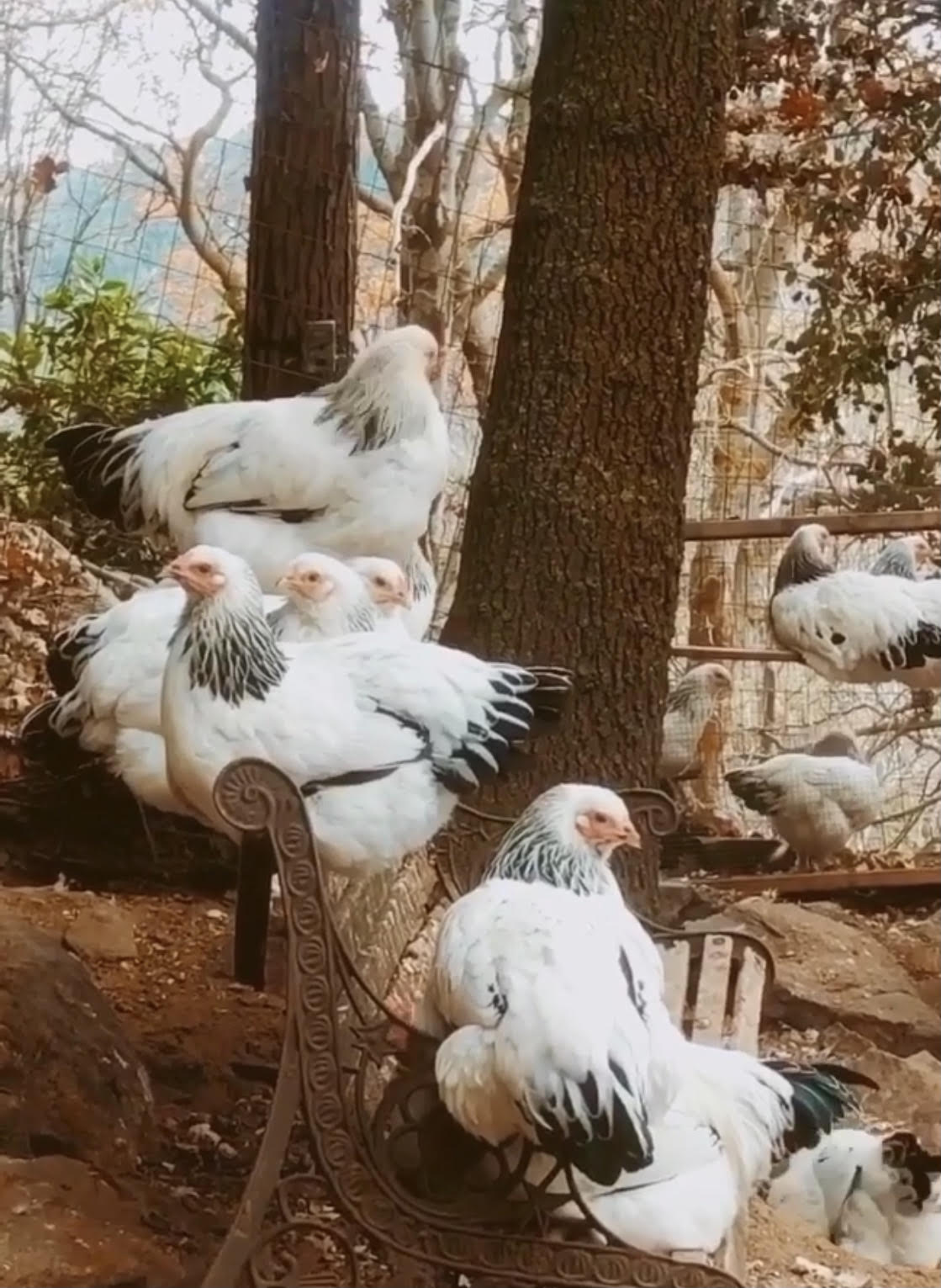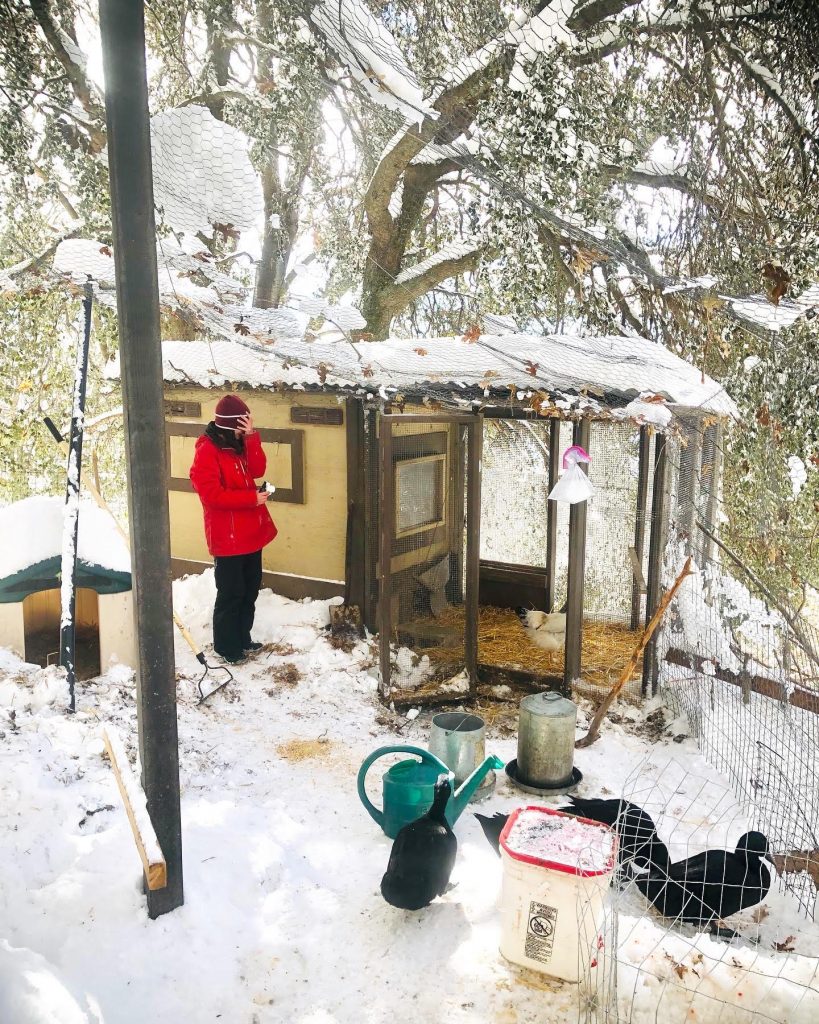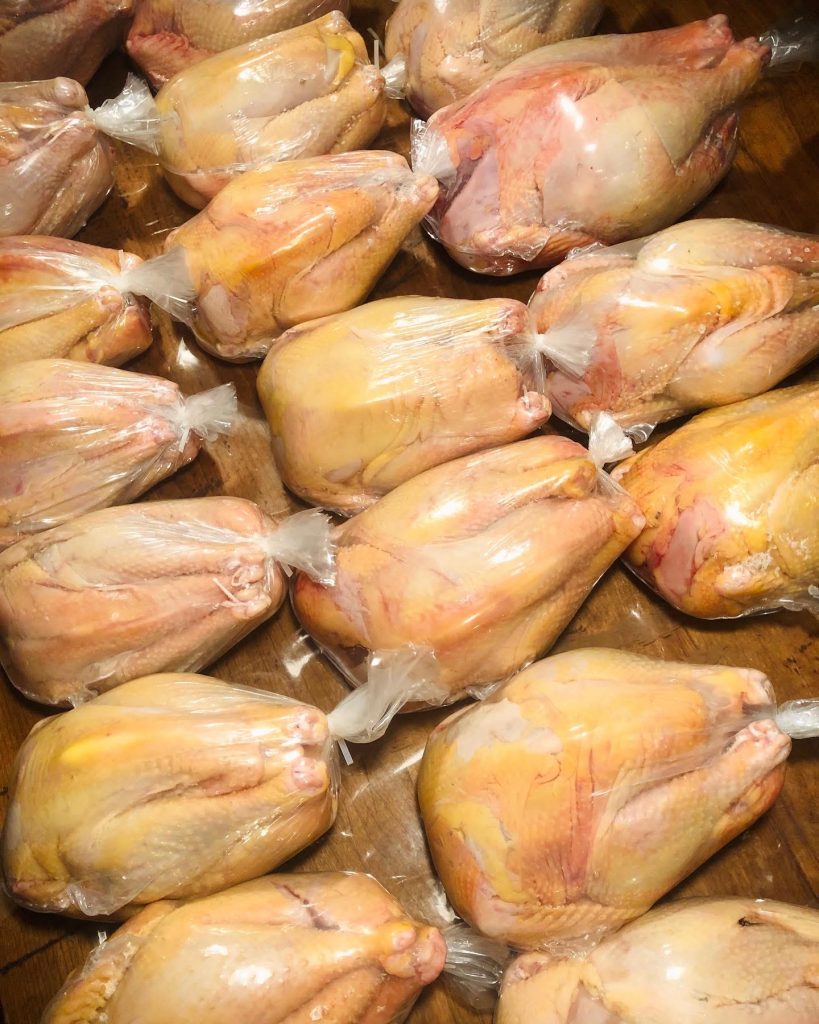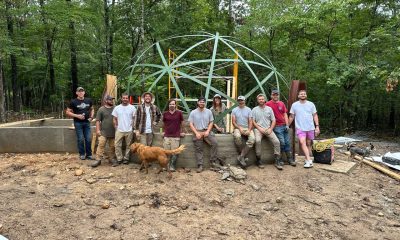Lifestyle
Homesteading… Life in the Fast Lane
The Lessons Learned Through Failure and Loss…

The Lessons Learned Through Failure and Loss…
A winter storm was rolling in, and that puts any homestead into high gear getting ready for the snow and freezing. The high anxiety and pressure gets everyone moving to prep the farm for the coming snow. It’s quickly checking fences, filling and covering feed, adding extra fluff, filling and moving water troughs all at double speed. There was so much to think about and do with storms, but with a team of six helping , we were able to settle down around dusk, just before the storm rolled in.
A massive three feet of heavy snow fell quickly over the next twenty-four hours. The first night of the storm, our two puppy livestock guardian dogs, named Enoch and Eden, were barking relentlessly. Since we live in a community surrounded by other cabins, we have to be conscious of the non-stop barking that can naturally occur with LGDs. So, we have training crates for them to sleep in until fully trained. When they wouldn’t quit barking at 5 A.M., I turned their crates around so they’d be quiet and stop being stimulated by looking out over the animals. It worked, and I went back to bed.
An hour later, it was time to get up and feed the animals. I let Enoch and Eden out, and they immediately went crazy barking and running towards the main chicken coop. I wasn’t sure if this was simply an act of adolescence, or was there a predator there needing my attention?
The phone rang pulling me away; a call from my work letting me know that it was a snow day and I wouldn’t be teaching students today. Yeah, extra sleep! Things were looking good. But, the loud barking brought me back to the situation at hand.
I hesitantly stepped out into the storm to take a look. I now had my “fancy pants” on, it was freezing outside, and I could actually sleep in another hour. So, I called the dogs back, locked them in their kennels, and went back inside where it was warm. All was well in the world. I fell back asleep.
My eldest son who is about thirteen took the liberty of checking on the birds for me when he noticed Mom and Dad were still sleeping past the usual time. That was when he ran inside into our room. With tears streaming down his face, barely able to speak, he said he thinks that all the birds froze to death. We couldn’t believe it was that cold, and we ran out to check. Upon further inspection, we found the roof caging had broke making it vulnerable to predators. That’s when, after closely looking at the birds, we knew it was a bobcat that had killed nineteen of our chickens and four of our ducks.

When I first looked at the massacre, I must admit, I didn’t handle it very well. Immediately, I knew they were dead because of my mistake. I let out a very loud curse in front of my children and wife, and blasted out the energy and shame I was feeling with emotion. It was not the right thing to do. It’s those moments in life, a family needs the father to be the strength. And, I failed them.
Homesteading puts your learning on an exponential curve. The extreme highs and lows that come several times a year for most, come almost daily when you homestead. It’s God’s accelerated school for learning Truth. I had to humble myself, pray, and quickly return as the role of father.
We processed twenty-three chickens that day. We had all the equipment, for we planned to process some birds in the future, however God had other plans. The saving grace to the horror and death we all experienced was to not let the meat go to waste. Our meat fridge was low on beef, but after processing the entire day as a family, our meat fridge was full again. Every lesson in suffering and hardship, God can work towards His glory.

The birds were dead because of me. If a homesteader gets weak, for even one night, they can lose nine months effort in the blink of an eye. In all honesty, I did not handle this test very well but took a great lesson with it. I apologized to my family, took responsibility for mistakes I made, burned my “fancy pants” and grew from the experience. For that was all I could do. The damage was done.
Tough Lessons Learned
This heavy and terrible experience did not break our spirit though. That week, the fences and roofing were reinforced and repaired. We all stepped up to take better care of all the animals we still had in our care. When the dogs bark, I now head their warning. I get up several times a night now when the dogs bark. It’s tiring, but the alternative is dead animals and a deflated family that feels like there’s no point. Laziness is not an option with this much responsibility.
Living on a homestead, it does seem that I’ve asked for some accelerated learning. When the people started closing their businesses, I knew this was the “Go Time”. I asked the Lord to allow me to finish strong and to teach me what I needed to know in order to finish the race worthy of Him. He said, “Build your homestead and control your mouth.” I thought that would be such an easy task, especially the mouth part. I actually felt insulted. Boy, was I wrong and massively humbled.
For all you Bears out there that are already homesteading, you have my utmost honor and respect. If you’ve been doing it for some time successfully, I can guarantee you are a human of high character and quality. I hope to one day reach that level. For those of you with little garden experience or a few chickens or quails, God Bless you! You are pushing yourself and learning serious life lessons daily. If you are still waiting for the right opportunity to begin, that time is now. Life’s lessons speed up when you’re in charge of other’s lives.
When tragedy at the homestead hit. It taught me much more than how to fix fences, check for predators, and process meat. I learned that I have much to learn about character and leadership when life’s challenges come my way. As a Father, how I handle the situation, in what I say and do, matters when the inevitable lessons of homesteading come my way.
If you want to accelerate your learning, it’s time to take more responsibility for others, and in turn, you will get more responsibility over your own self. There is no hiding responsibility when homesteading. Yes, I failed. It was hard on the family. But, the rewards you get from overcoming challenges, learning from mistakes, and becoming better as a team is worth the struggle.

Social media shows doomsayers, pessimists, and even truther-prepper types blasting out warnings of impending doom and gloom. You may feel the urge to fight if you can bear this without your emotions causing you to flee or freeze.
But what does fighting for your future mean? Unfortunately, much internet commentary directs your focus to what others are doing and how they affect you, calling for action to demand change. While this may have its place, it neglects the freedom we already possess and can inadvertently bypass our authority and control.
Here are a few simple things to think about that can help you fight against the future you don’t want, by building the future you do want.
Financial Future
Securing your financial stability is the cornerstone of building a successful future. This starts with becoming debt-free. Debt is a shackle that limits your freedom and ties you to a system you might not align with. Aim to clear your debts quickly and avoid taking on new ones.
Next, focus on land ownership. Owning land provides a place to call home and offers opportunities for self-sufficiency, such as gardening, raising livestock, or even setting up a small business. This autonomy can buffer against economic uncertainties and offer a sense of security.
Continually work towards a sustainable income. Whether through traditional employment, investments, freelancing, or entrepreneurial ventures, ensure your income sources are diversified and resilient to economic shifts. Build skills that are in demand and can be adapted to various roles. Financial independence is crucial in crafting a future you control rather than one external force dictates.
Education
Education is the foundation of personal and professional growth. Embrace self-study and continuous learning. The more skills and knowledge you acquire, the more adaptable you become in a rapidly changing world. Invest in personal improvement by setting aside time for reading, courses, and practical skill-building.
Homeschooling is another powerful tool. It allows you to tailor education to your family’s needs and values, ensuring your children learn what truly matters. Foster a love of learning in your household, emphasizing critical thinking, creativity, and practical skills over rote memorization.
Family Protection
Protecting your family goes beyond physical safety; it involves being a guiding force and a source of stability. We must also protect our families from negative and misguided influences. Be a leader to your children by setting a positive example. Teach them resilience, self-reliance, and the importance of moral values. Strengthen bonds with your siblings through support and cooperation, creating a solid familial network.
Honoring your seniors is equally essential. They possess invaluable wisdom and experience. Encourage intergenerational communication and respect, ensuring your family’s heritage and lessons are passed down.
Mindset
Your mindset is the driving force behind every action. Take ownership of your life and decisions, understanding that responsibility and accountability are keys to freedom. Respect your time and finances, recognizing them as finite resources that require careful management.
Develop a mindset of resilience and adaptability. Life is unpredictable, and being mentally prepared for challenges ensures you can face them head-on. Cultivate a positive outlook, focusing on solutions rather than problems. This proactive attitude will guide you in building the life you want.
Community Building
No one succeeds alone. Connect with people who share your values and vision. Building a community of like-minded individuals offers support, shared resources, and collective wisdom. Engage in activities and friendships that bring joy and complement your life.
We would like to take it a step further by saying, we don’t build the future we want as a reaction to the future we don’t want. We build, because we love, its fun and fulfilling. Our fight is to thrive, not to survive. Survival is a consequence of thriving. So aim high! Take control of your life, embrace self-responsibility, and connect with others on the same path.
Those looking to connect with a broader network should consider joining our Community app. It’s a platform dedicated to bringing together individuals who strive for independence. Whether you’re looking for advice, collaboration, or simply companionship on your journey, our thriving community is a valuable resource.
The power to shape your future is in your hands.
Lifestyle
Making Pine Needle Soda: A Fantastic Foraged Beverage
Pine needle soda, a truly one-of-a-kind beverage, has been savored worldwide for its zesty taste and health benefits.

Pine needle soda, a truly one-of-a-kind beverage, has been savored worldwide for its zesty taste and health benefits. It’s not just a refreshing drink, but also a creative use of natural ingredients. Here’s a simple guide to crafting this unique soda at home.
Pine needles are rich in antioxidants and vitamin C, which help boost the immune system. Different species of needles can offer different flavors, but it’s important to make sure the trees you harvest from are not toxic. Avoid using needles from yew, Norfolk Island pine, or Ponderosa pine. You should do additional research to insure you are staying safe.
The recipe I followed is easy and only requires a jar, strainer, and measuring cups. Start by identifying the pine tree you would like to harvest from; I used fir, tamarack, and white pine. Again, make sure you don’t use anything unsafe. You can choose to use new sprouted tips or even mature needles, which means you can also have fresh pine soda in the winter months!
You can scale up the recipe, but for reference, use the following:
- 2 Cups Pine needles
- 2 Cups Water
- 2-4 Tablespoons sugar (depending on sweetness you desire)
For the above measurements, I recommend using a quart jar. Begin by rinsing the needles, not too thoroughly, because the carbonation comes from natural yeast living on the pine needles. Add the sugar and water and seal the jar. Leave to ferment so it can become bubbly soda! Make sure to “burp” the jar every couple of days to release some of the gas so it does not build up and explode the jar! In 5-7 days, you will have soda, God willing.
Serve over ice and with some citrus if you’d like. Enjoy!
Lifestyle
Reconnect and Rejoice: Beartaria Times Weekly Challenge
Maintaining solid relationships with family and friends offers numerous benefits that enrich our lives in meaningful ways…

In our fast-paced world, losing touch with friends and family members who once played significant roles in our lives is easy. This week, the Beartaria Times invites you to participate in our heartwarming challenge: Reconnect with someone you haven’t spoken to in a while. Give them a call, ask how they’ve been, and rekindle that bond.
Maintaining solid relationships with family and friends offers numerous benefits that enrich our lives in meaningful ways:
1. Emotional Support: Close relationships provide a robust support system during tough times, offering comfort, advice, and a sense of belonging.
2. Improved Mental Health: Regular interactions with loved ones reduces feelings of loneliness and depression, contributing to mental well-being.
3. Increased Longevity: Studies have shown that strong social connections tend to help people live longer and enjoy better health.
4. Enhanced Happiness: Sharing moments, memories, and experiences with others brings joy and fulfillment, fostering a more positive outlook on life.
5. Personal Growth: Friends and family often challenge us to grow, learn, and become better versions of ourselves.
6. Creating Memories: Every interaction creates new memories, adding richness to our personal histories and offering stories to cherish for years to come.
We encourage you to take this challenge to heart and reach out to someone you miss. Whether it’s a friend from high school, a distant relative, or a former colleague, a simple phone call can reignite connections and brighten your day and theirs.
Once you’ve reconnected, share your stories and experiences on the Beartaria Times community app. Post about who you called, the memories you shared, and how the conversation went. Did you learn something new? Did you laugh about old times? These stories can inspire others to take similar steps in their lives.
Join us in this week’s challenge and celebrate the beauty of human connection. Let’s make an effort to nurture our relationships and remind those we care about that they are valued and remembered.
Happy connecting, Beartarians! We look forward to hearing your heartwarming stories.
Sincerly,
– The Beartaria Times Team
-

 Just Crushing2 weeks ago
Just Crushing2 weeks agoChristopher Gardner Completes First Dome Framing Project in Missouri: Exclusive Interview
-

 Just Crushing2 months ago
Just Crushing2 months agoBeartaria Ozark Campground Launches Community Forum!
-

 Just Crushing2 months ago
Just Crushing2 months agoMap it! – Discover Beartarians Living, Working, and Crushing Near You!
-

 Just Crushing2 months ago
Just Crushing2 months agoWhy Do We Feel So Free?
-

 Lifestyle2 months ago
Lifestyle2 months agoReconnect and Rejoice: Beartaria Times Weekly Challenge
-

 Reports2 months ago
Reports2 months agoReport: EF-1 Tornado Touches Down In The Ozarks
-

 Business2 months ago
Business2 months ago3000 Members In Our Business Group!: This Week On Our Community App!
-

 Wellness2 months ago
Wellness2 months agoBeartaria Times Member Shares History and Benefits of Haymaker’s Punch



































